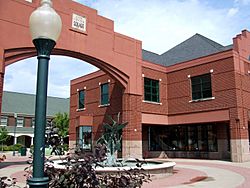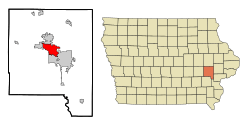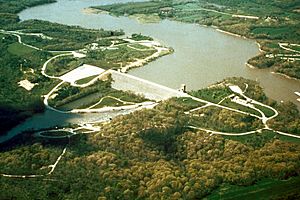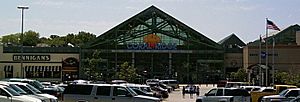Coralville, Iowa facts for kids
Quick facts for kids
Coralville, Iowa
|
||
|---|---|---|

City Center Square in downtown Coralville
|
||
|
||
| Nickname(s):
CoralVegas
|
||

Location of Coralville, Iowa
|
||
| Country | United States | |
| State | Iowa | |
| County | Johnson | |
| Metro | Iowa City Metropolitan Area | |
| Incorporated | 1873 | |
| Government | ||
| • Type | Council–manager | |
| Area | ||
| • Total | 12.67 sq mi (32.82 km2) | |
| • Land | 12.60 sq mi (32.64 km2) | |
| • Water | 0.07 sq mi (0.18 km2) | |
| Elevation | 682 ft (208 m) | |
| Population
(2020)
|
||
| • Total | 22,318 | |
| • Rank | 23rd in Iowa | |
| • Density | 1,771.13/sq mi (683.83/km2) | |
| Time zone | UTC-6 (Central (CST)) | |
| • Summer (DST) | UTC-5 (CDT) | |
| ZIP code |
52241
|
|
| Area code(s) | 319 | |
| FIPS code | 19-16230 | |
| GNIS feature ID | 0455624 | |
| Website | www.coralville.org | |
Coralville is a city in Johnson County, Iowa, United States. It is a suburb of Iowa City and part of the Iowa City Metropolitan Statistical Area. The population was 22,318 at the 2020 census.
Contents
History of Coralville
Coralville is home to the Edgewater Park Site. This is an archaeological site along the Iowa River. It is about 3,800 years old. Edgewater is the oldest place in Iowa with proof that people used plants they grew.
Coralville became an official city on June 1, 1857. The city's name comes from the many fossils found in the limestone along the Iowa River. In 1864, Louis Agassiz, a Harvard University zoologist, gave a talk at the nearby University of Iowa. He called it "The Coral Reefs of Iowa City." He showed off local samples of fossilized Devonian period coral. This talk made people very interested in the local fossils. In 1866, more corals were found where a new mill was being built. This inspired the people to name the area "Coralville."
The first mill in Coralville was built in 1844. Over the years, many watermills used power from the Coralville mill dam on the Iowa River. By 1900, all the mills had closed. Only a small hydroelectric plant kept working until the mid-1900s.
Mormon Handcart Pioneers
Coralville was also a stopping point for about 1,300 Mormon immigrants in 1856. They had traveled west by train to Iowa City. This was the end of the train line at that time. They built handcarts from local wood during their stop. An adult could pull a cart with 600–700 pounds of supplies. They could walk about 15 miles a day on their journey to Salt Lake City.
A historical marker was put up in 1936 to remember the Mormon Handcart Brigade. It was moved in 1998 to S. T. Morrison Park. Today, the Mormon Handcart Park and Nature Preserve remembers this important site. There is also a street called Mormon Trek Blvd. It is named after the Mormons who traveled through that area.
Growth and Development
After World War II, Coralville started to grow a lot. Many university students began to live there. In 1940, only 433 people lived in Coralville. By 1970, the population had jumped to 6,130. When Interstate 80 was built in the 1960s, many motels, fast-food restaurants, and gas stations opened in Coralville.
In the mid-1960s, Coralville's school district joined the Iowa City Community School District. Older students took buses to Iowa City schools. Younger students (K-6) went to Central Elementary School. Kirkwood Elementary school opened in 1964 as the town's second school. By 1968, all high school students from Coralville went to the new West High School. In 1971, Northwest Junior High was built. It served seventh and eighth graders living west of the Iowa River. Wickham Elementary School opened in 1997.
In 1958, the United States Army Corps of Engineers finished the Coralville Dam. It is on the Iowa River, about four miles (6 km) north of the city. This created Coralville Lake. The dam has helped stop serious flooding in the city. However, there were big floods in 1993 and 2008. In 1993, all three main roads connecting Coralville to Iowa City were underwater. The city recovered quickly. The 2008 flood was even bigger. The Iowa River reached over 31.5 feet (9.6 meters).
The First Methodist Church was built in 1963. It was designed by architect Thomas Patrick Reilly.
On July 29, 1998, the Coral Ridge Mall opened. It had over 100 stores and was the largest shopping center in Iowa at the time. A "city center" area was also created nearby. The mall's opening brought many new big box stores to the area. This helped Coralville's sales grow a lot. Taxable sales went from $155.3 million in 1996 to $549.7 million in 2006.
Xtream Arena, a large venue with 5,100 seats, opened in 2020. It is in the Iowa River Landing neighborhood. Xtream Arena is home to the Iowa Heartlanders. This is a professional hockey team. They are connected to the Minnesota Wild and Iowa Wild teams.
Geography of Coralville
Coralville is located in Johnson County. Its coordinates are 41°41′18″N 91°35′12″W.
The city covers a total area of about 12.05 square miles (31.21 square kilometers). Most of this is land (12.01 sq mi or 31.11 sq km). A small part is water (0.04 sq mi or 0.10 sq km).
The Iowa River runs along the east side of Coralville. It forms part of the border with Iowa City. Interstate 80 goes east–west through Coralville. Most of the city's newer homes are north of I-80. U.S. Route 6 runs along Coralville's south edge. Interstate 380, U.S. Route 218, and Iowa Highway 27 run along the city's west edge. The big interchange where I-80 and I-380 meet is partly in Coralville and partly in nearby Tiffin.
People of Coralville (Demographics)
| Historical populations | ||
|---|---|---|
| Year | Pop. | ±% |
| 1880 | 347 | — |
| 1890 | 173 | −50.1% |
| 1900 | 125 | −27.7% |
| 1910 | 151 | +20.8% |
| 1920 | 150 | −0.7% |
| 1930 | 254 | +69.3% |
| 1940 | 433 | +70.5% |
| 1950 | 977 | +125.6% |
| 1960 | 2,357 | +141.2% |
| 1970 | 6,130 | +160.1% |
| 1980 | 7,687 | +25.4% |
| 1990 | 10,347 | +34.6% |
| 2000 | 15,123 | +46.2% |
| 2010 | 18,907 | +25.0% |
| 2020 | 22,318 | +18.0% |
| Source:
|
||
2020 Census Information
In 2020, there were 22,318 people living in Coralville. They lived in 9,584 households. The population density was about 1,776 people per square mile (683.8 people per square kilometer).
Most people (70.2%) were White. Other groups included Black or African American (13.9%), Asian (9.4%), and people of two or more races (5.5%). About 4.2% of people were Hispanic or Latino.
Of the households, 39.7% were married couples. About 20.9% were male householders without a spouse. And 30.9% were female householders without a spouse. On average, there were about 2.24 people per household. Most people (74.8%) had lived in the same home for the past year. About 15.3% of residents were born outside the United States.
The average age in Coralville was about 32.6 years old. About 20.3% of residents were under 18. And 13% were over 65. Slightly more than half (51.2%) of the residents were male.
The average household income from 2018-2022 was $67,691. The income per person was $47,434. About 10.7% of Coralville residents were living in poverty.
Media in Coralville
Coralville has one local radio station, KOUR-LP at 92.7 FM. KCJJ 1630 AM, which is licensed to Iowa City, used to broadcast from Coralville.
Coralville and Johnson County are part of the Cedar Rapids media market. Mediacom provides cable television service in the city.
Transportation in Coralville
Local bus service is provided by Coralville Transit. Bus service to Iowa City and Cedar Rapids is provided by the 380 Express.
Notable People from Coralville
- Tina L. Cheng, Chair of Pediatrics at Cincinnati Children's Hospital Medical Center.
- Nate Kaeding, former placekicker for the San Diego Chargers and University of Iowa.
- Samuel J. Kirkwood, former Governor of Iowa, Senator from Iowa, and Secretary of the Interior.
- Jason McCartney, professional cyclist for Team RadioShack.
- Jeremy Morgan (born 1995), basketball player for Hapoel Jerusalem in the Israeli Basketball Premier League.
- Steven B. Jepson, opera and musical theater singer.
See also
 In Spanish: Coralville (Iowa) para niños
In Spanish: Coralville (Iowa) para niños







